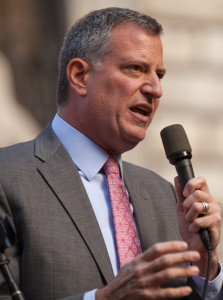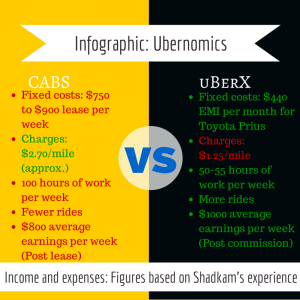By Alexa Ritacco
As a college student in LA, Uber has become an essential way to get around, especially when it comes to nightlife. It even has its own verb now: “Oh yeah, let’s just uber.”
Founded in 2009, Uber now exists in sixty countries, and over three hundred cities. In just six years Uber has become a globally used and extremely well-known app. But global success does not necessarily mean global acceptance. Resistance to the ride sharing service has come about from all angles. Some consumers think the service is sketchy.
There have been numerous reports of harassment, extortion, and sometimes even robbery, and Uber’s response to such reports have been pretty mixed. In a few cases, in response to reports of sexual harassment, Uber offered users a small credit. They typically do not release any type of statements in response to reports against them, and have been criticized in their slow response to release names of drivers in said harassment scandals. But some view Uber as the lesser of two evils.
“I would much rather hop in an Uber than a taxi cab,” said NYU student Elizabeth Gurdus, “Taxi drivers are so incredibly rude, and never take the route that I want to go. Uber drivers have a rating incentive to make the experience at least somewhat pleasant, and generally, that’s been the case in my experience.”
While consumer perception has been an issue, the most resistance to Uber has come from city taxi cab drivers, as well as local city legislation. New York City, a place known for its thriving taxi sector with the instantly recognizable yellow cabs, has seen quite a bit of controversy surrounding Uber and other ride-sharing services.
Uber launched in New York in May of 2011. Since then, the service has exploded, having given millions of rides to New Yorkers, and employing over 30,000 drivers. And it has been driving the NYC taxi drivers absolutely insane. Many drivers claim to be taking a hit financially, and feel that it is completely unfair that Uber just waltzed in one day and began stealing customers. They feel betrayed by New York City for letting this go on.
For so long, they were the only ones on the market for private transportation around the city. If a New Yorker wasn’t taking the subway, bus or personally driving themselves, chances are they were taking a taxi. And really, that was their only other option. Now, suddenly, the consumer has quite a few options when they’re strapped for a ride. Rather than stepping out onto the sidewalk and hailing a cab, they very well may be whipping out their phone and calling for an Uber or a Lyft. The transportation market has changed completely, and now taxis are dealing with some very hungry competitors.
For decades, New York City has controlled the number of taxis by limiting the number of medallions, which is required to legally operate a taxi. Introduced in 1937 by Mayor Fiorello H. La Guardia, the medallion system was created to remedy the overflow of cab drivers that the city was facing at the time. It set limits to the number of cabs licenses that could operate in the city.
This caused prices for medallions to shoot through the roof over the years, seemingly posing as what would prove to be a good investment for anyone who acquired a medallion. The price of medallions has gone as high as one million dollars, and currently, medallions listed for sale online range from about $500,000 to $700,000. Generally, people that own the medallions do not drive the taxis; the medallions are leased to drivers who are then responsible to pay money back to the owners, or the company of the owners.
One of the reasons that the price of medallions has risen so high in the past is because of scarcity. For so long, this is how the taxi market survived and prospered. But the rise of ride-sharing services like Uber and Lyft have totally threatened this. Taxi drivers and taxi companies are required to pay heavy taxes and fees in order to operate legally. Uber has managed to get around this, creating a completely uneven playing field. Medallion owners are essentially watching their investments plummet as Uber rises in the ranks. The question of fairness in the market has become a big issue. Most taxi companies, medallion owners and drivers feel completely blindsided. The entire industry is being threatened.
Taxi medallion owners have put a lot of pressure on Mayor Bill de Blasio’s administration to help them and act in their favor. Satwinder Singh, a NYC Taxi Medallion owner gave this analogy in a New Yorker article, “The city is the father and mother. They created the yellow cab as the baby. Now they’re refusing to take care of it!”
Another owner, Lal Singh, continued the analogy citing, the fifty cent tax that is charged on cab fares that goes directly to the MTA. “We’re giving them eighty-five million dollars a year! And yet everybody accepts Uber is the stepfather and all the politicians are the stepsons!” he said.
After much badgering, de Blasio pushed to start regulation and capping on Uber in NYC in the late Spring of 2015. The legislation would basically limit the amount of Uber drivers that could be in New York City at all times, and prohibit any further growth of the company in the city.
This launched Uber into full-on defense mode. They put out countless adds dissing taxi cabs, attacking their well-known racist stereotyping practices, as well as pushing all of the different types of services they offer, ranging from Pool to Lux. They rallied support from consumers in the form of petitions and protests, and even got a few celebrity endorsements via Twitter, including Kate Upton, Neil Patrick Harris and Ashton Kutcher.
It came as no surprise to many when de Blasio decided to halt his efforts to place a cap on Uber while further studies were conducted to see really just how hard Uber is hitting the transportation market. Obviously, this infuriated NYC cab drivers and launched them into a series of protests. Some of the leaders of these protests have gone as far as to suggest emulating what cab drivers in Paris did in response to Uber, which included blocking major intersections and entrances to airports. But until something drastic happens, for now, it looks like Uber will not be leaving New York anytime soon.
Since Uber is still a private company, it is pretty difficult to tell just how much of an impact hey are having on the transportation market. But by looking at employment numbers, leaked reports and the cab side of things, it is pretty easy to tell that Uber has made a giant mark on the Big Apple. A New York Post article reported that as of October 2015, 30,000 Uber drivers are employed in New York, and that they could be making an average of $40 per hour. Forbes reported that the number of Uber drivers has nearly doubled every six months over the last two years. The growth of the company, from every angle, appears to be unstoppable. In November of 2014, it was leaked that Uber was set to generate $350 million in revenue for that year. It could have only grown since then.
Business Insider recently noted that the number of abandoned taxi cabs in Brooklyn outside of dispatcher offices has been on the rise. Many drivers have reported that they jumped ship for Uber. By doing this, they lose the worry of paying the lease on their cab, and the countless other fees that cab drivers that do not own their own medallions have to pay.
The next step in this big move from taxi driver to Uber driver is purchasing a car. The question of cost comes into play. In a Neon Tommy article where a Los Angeles based cab driver who switched to Uber, it is illustrated that car payments end up being way lower payments than leasing a cab. Plus, they are getting a personal vehicle out of the deal.
Based on all of these factors, there is no doubt that Uber has taken a large bite into the transportation market in New York City. So will this mean the end of taxi cabs in NY? Of course not. But this situation has forced taxicab companies to start thinking towards the future. It has been reported that they have been developing apps similar to Uber for cab drivers to being using. Features would include GPS based fares as well as a possible rating system.
Uber has awoken what was otherwise a sleepy transportation market in New York. It is most definitely worth recognizing some of the disparities in the fairness of the situation in this war between Uber and taxis. While Uber may be the cool new kid in town, taxis are still an integral part of the city, and most likely will always be. Only time will tell what will come of the industry, and if these two competitors will ever be able to peacefully coexist.
Sources:
http://www.forbes.com/sites/briansolomon/2015/05/01/the-numbers-behind-ubers-exploding-driver-force/
http://www.neontommy.com/news/2014/03/why-did-l.a.-cab-driver-switch-to-uberx
http://money.cnn.com/2015/07/21/news/companies/nyc-yellow-taxi-uber/
http://www.theatlantic.com/technology/archive/2015/04/he-said-she-said-how-uber-relied-on-data-in-an-assault-dispute/389811/
https://www.washingtonpost.com/news/wonk/wp/2014/06/20/taxi-medallions-have-been-the-best-investment-in-america-for-years-now-uber-may-be-changing-that/
http://www.businessinsider.com/uber-revenue-rides-drivers-and-fares-2014-11?op=1
http://www.businessinsider.com/proof-that-uber-is-obliterating-new-york-citys-taxi-industry-2015-8
http://www.newyorker.com/magazine/2015/08/03/revving-up
http://newyork.cbslocal.com/photo-galleries/2015/09/17/medallion-taxi-drivers-rally-against-uber-drivers/
http://www.capitalnewyork.com/article/city-hall/2015/09/8577153/uber-fight-city-hall-overshadows-congestion-hearing
http://nypost.com/2015/10/07/there-are-more-than-30000-uber-drivers-working-in-nyc/
https://nextcity.org/daily/entry/number-of-uber-drivers-in-nyc
http://www.nydailynews.com/news/politics/n-y-taxi-drivers-rally-uber-article-1.2363707
http://www.cbsnews.com/news/uber-defends-surge-pricing-with-nyc-case-study/
<rdf:RDF xmlns:rdf=”http://www.w3.org/1999/02/22-rdf-syntax-ns#” xmlns:dc=”http://purl.org/dc/elements/1.1/” xmlns:trackback=”http://madskills.com/public/xml/rss/module/trackback/”> <rdf:Description rdf:about=”http://j469.ascjclass.org/?p=1399″ dc:identifier=”http://j469.ascjclass.org/?p=1399″ dc:title=”Uber takes a bite out of the Big Apple” trackback:ping=”http://j469.ascjclass.org/wp-trackback.php?p=1399″ /> </rdf:RDF>





Leave a Reply
You must be logged in to post a comment.